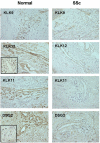A model of anti-angiogenesis: differential transcriptosome profiling of microvascular endothelial cells from diffuse systemic sclerosis patients
- PMID: 16859528
- PMCID: PMC1779372
- DOI: 10.1186/ar2002
A model of anti-angiogenesis: differential transcriptosome profiling of microvascular endothelial cells from diffuse systemic sclerosis patients
Expression of concern in
-
Editorial Expression of Concern: A model of anti-angiogenesis: differential transcriptosome profiling of microvascular endothelial cells from diffuse systemic sclerosis patients.Arthritis Res Ther. 2025 Mar 31;27(1):73. doi: 10.1186/s13075-025-03549-0. Arthritis Res Ther. 2025. PMID: 40165240 Free PMC article. No abstract available.
Abstract
The objective of this work was to identify genes involved in impaired angiogenesis by comparing the transcriptosomes of microvascular endothelial cells from normal subjects and patients affected by systemic sclerosis (SSc), as a unique human model disease characterized by insufficient angiogenesis. Total RNAs, prepared from skin endothelial cells of clinically healthy subjects and SSc patients affected by the diffuse form of the disease, were pooled, labeled with fluorochromes, and hybridized to 14,000 70 mer oligonucleotide microarrays. Genes were analyzed based on gene expression levels and categorized into different functional groups based on the description of the Gene Ontology (GO) consortium to identify statistically significant terms. Quantitative PCR was used to validate the array results. After data processing and application of the filtering criteria, the analyzable features numbered 6,724. About 3% of analyzable transcripts (199) were differentially expressed, 141 more abundantly and 58 less abundantly in SSc endothelial cells. Surprisingly, SSc endothelial cells over-express pro-angiogenic transcripts, but also show up-regulation of genes exerting a powerful negative control, and down-regulation of genes critical to cell migration and extracellular matrix-cytoskeleton coupling, all alterations that provide an impediment to correct angiogenesis. We also identified transcripts controlling haemostasis, inflammation, stimulus transduction, transcription, protein synthesis, and genome organization. An up-regulation of transcripts related to protein degradation and ubiquitination was observed in SSc endothelial cells. We have validated data on the main anti-angiogenesis-related genes by RT-PCR, western blotting, in vitro angiogenesis and immunohistochemistry. These observations indicate that microvascular endothelial cells of patients with SSc show abnormalities in a variety of genes that are able to account for defective angiogenesis.
Figures





References
-
- Haustein UF. Systemic sclerosis-scleroderma. Dermatol Online J. 2002;8:3. - PubMed
-
- Mignatti P, Rifkin DB. Biology and biochemistry of proteinases in tumor invasion. Physiol Rev. 1993;73:161–195. - PubMed
-
- Rifkin DB, Mazzieri R, Munger JS, Noguera I, Sung J. Proteolytic control of growth factor availability. APMIS. 1999;107:80–85. - PubMed
Publication types
MeSH terms
Substances
LinkOut - more resources
Full Text Sources
Other Literature Sources
Medical
Miscellaneous

